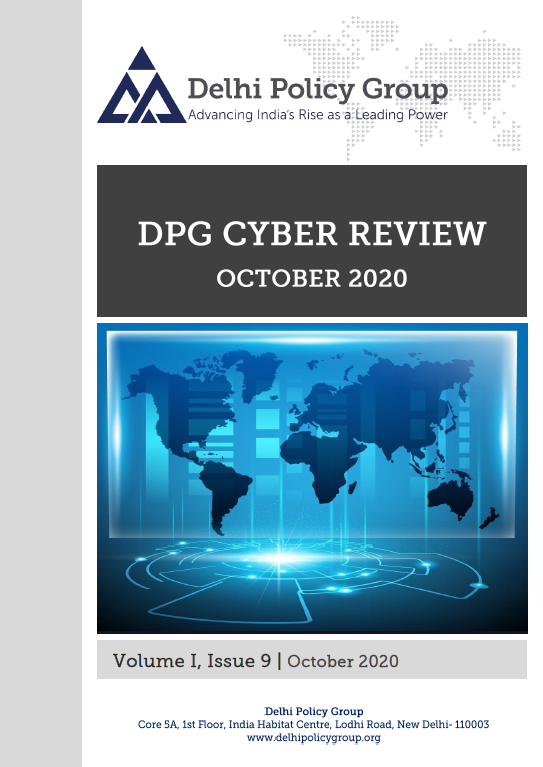Volume 1, Issue 9
Date: November 16, 2020
India continues to be a target of unabated cyber-attacks by Pakistan and China. Important attacks included Dr. Reddy’s Lab and the Press Trust of India. Frequency of the cyberattacks highlight the need to strengthen digital infrastructure and tighten cyber security control measures across all sectors in the country.
Month also saw the enunciation of new space policy that will open up the space sector to private Indian entities, encourage foreign direct investment and allow foreign companies to set up facilities for space related activities.
In the telecom sector there is growing understanding of the centrality of backbone infrastructure in particular spectrum allocation and fiberisation of towers as crucial to the rollout of 5G. Furthermore, in adoption of standards for 5G networks, there is a need to balance between the home-grown national standards and widely accepted international standards.
On the use of artificial intelligence (AI), Prime Minister Narendra Modi, while inaugurating the global virtual summit on artificial intelligence (AI), “Responsible AI for Social Empowerment (RAISE 2020)” on October 5, highlighted how the AI can empower India, while cautioning about the possible weaponisation of AI technologies by non-state actors.
Rational spectrum allocation is crucial for the growth of communication technologies. Towards this the government has constituted a Committee of secretaries (COS) to streamline the spectrum allocation process that will give a clear road map for the deployment of next generation networks.
On the international front, the semiconductor industry in the US is witnessing consolidation with new mergers and acquisitions. On October 27, Advanced Micro Devices Inc. (AMD) announced the plans to buy rival chip maker Xilinx Inc. in a $35 billion deal. In another development the U.S. National Security Council, on October 13, issued “National Strategy for Critical and Emerging Technologies (C&ET)”, that aims at ensuring the United States, its allies and partners, continue to be the world leader in C&ET.
To further boost bilateral cooperation between India and Japan in the field of cybersecurity, information and communication technologies (ICT), Indian cabinet approved the signing of the Memorandums of Cooperation (MoC) which is likely to be signed at the India – Japan Summit later this year. To address the issue of communications security the members of the intelligence-sharing “The Five Eyes” alliance, together with Japan and India, urged the ICT industry to address concerns of communications with end to end encryption that prevents legal access to the content by Law Enforcement Authorities.
Month also saw the enunciation of new space policy that will open up the space sector to private Indian entities, encourage foreign direct investment and allow foreign companies to set up facilities for space related activities.
In the telecom sector there is growing understanding of the centrality of backbone infrastructure in particular spectrum allocation and fiberisation of towers as crucial to the rollout of 5G. Furthermore, in adoption of standards for 5G networks, there is a need to balance between the home-grown national standards and widely accepted international standards.
On the use of artificial intelligence (AI), Prime Minister Narendra Modi, while inaugurating the global virtual summit on artificial intelligence (AI), “Responsible AI for Social Empowerment (RAISE 2020)” on October 5, highlighted how the AI can empower India, while cautioning about the possible weaponisation of AI technologies by non-state actors.
Rational spectrum allocation is crucial for the growth of communication technologies. Towards this the government has constituted a Committee of secretaries (COS) to streamline the spectrum allocation process that will give a clear road map for the deployment of next generation networks.
On the international front, the semiconductor industry in the US is witnessing consolidation with new mergers and acquisitions. On October 27, Advanced Micro Devices Inc. (AMD) announced the plans to buy rival chip maker Xilinx Inc. in a $35 billion deal. In another development the U.S. National Security Council, on October 13, issued “National Strategy for Critical and Emerging Technologies (C&ET)”, that aims at ensuring the United States, its allies and partners, continue to be the world leader in C&ET.
To further boost bilateral cooperation between India and Japan in the field of cybersecurity, information and communication technologies (ICT), Indian cabinet approved the signing of the Memorandums of Cooperation (MoC) which is likely to be signed at the India – Japan Summit later this year. To address the issue of communications security the members of the intelligence-sharing “The Five Eyes” alliance, together with Japan and India, urged the ICT industry to address concerns of communications with end to end encryption that prevents legal access to the content by Law Enforcement Authorities.



